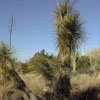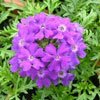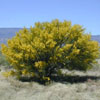Five Plants for your Desert Backyard
Wednesday, September 13, 2006Take for example, your Desert Backyard. Sure, you may want to have an emerald green expanse of lawn and trees, offset by a lovely rose garden or expansive beds of petunias and violets. Don't get me wrong, I love a well-kept lawn, but in the desert - it's just somehow wrong.
Most cities in the Southwest have restrictions on water use, or at the very least your neighbors will frown on extravagant use of the precious fluid. So let's take a look at what you can do to make your yard blend in with your surroundings and create interest to passers-by as well as for your own family.
Here are five of my favorite plants for a distinctive desert landscape
 1. Soaptree Yucca - This plant has long narrow spiky leaves attached to a main trunk-like body. The leaves are similar in appearance to an aloe, but thin, without the succulent centers. At the top of the main trunk a long stalk shoots up and at the top of the stalk a bunch of white flowers sprouts in the spring.
1. Soaptree Yucca - This plant has long narrow spiky leaves attached to a main trunk-like body. The leaves are similar in appearance to an aloe, but thin, without the succulent centers. At the top of the main trunk a long stalk shoots up and at the top of the stalk a bunch of white flowers sprouts in the spring.
 2. Ocotillo - A member of the cactus family, this plant is characterized by its long spiny "fingers" that grow from a single point at its base. As many as 75 of these canes can grow on one plant. Ocotillo occasionally sprouts tiny leaves all along the canes, especially after a rain. The ends of the canes sprout red flowers in spring to early summer.
2. Ocotillo - A member of the cactus family, this plant is characterized by its long spiny "fingers" that grow from a single point at its base. As many as 75 of these canes can grow on one plant. Ocotillo occasionally sprouts tiny leaves all along the canes, especially after a rain. The ends of the canes sprout red flowers in spring to early summer.
 3. Verbena - A flowering shrub that makes a good bedding plant or ground cover. Plants normally grow to one or two feet tall and a foot and a half wide. Some varieties grow to a height of four or five feet. Flowers range from yellow and white, to orange, red, and scarlet.
3. Verbena - A flowering shrub that makes a good bedding plant or ground cover. Plants normally grow to one or two feet tall and a foot and a half wide. Some varieties grow to a height of four or five feet. Flowers range from yellow and white, to orange, red, and scarlet.
 4. Palo Verde - A tree whos name means green stick in Spanish. It is a spiny green multi-trunked deciduous tree. The leaves are tiny, growing in matched pairs on both sides of a main stem. The flowers are yellow and proliferous. They produce a pod that contains six or eight seeds in each one similar to peas or beans.
4. Palo Verde - A tree whos name means green stick in Spanish. It is a spiny green multi-trunked deciduous tree. The leaves are tiny, growing in matched pairs on both sides of a main stem. The flowers are yellow and proliferous. They produce a pod that contains six or eight seeds in each one similar to peas or beans.
 5. Mexican Bird of Paradise - A perennial evergreen plant that is drought resistant, easy to grow and lovely to look at. The leaves are similar to ferns. The flowers are yellow with orange and red centers.
5. Mexican Bird of Paradise - A perennial evergreen plant that is drought resistant, easy to grow and lovely to look at. The leaves are similar to ferns. The flowers are yellow with orange and red centers.

